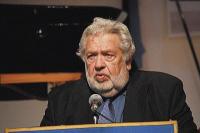
While Russian speakers have always lived in Tallinn over the centuries, many of them living in the capital today were shipped in from the USSR in 1945 after Estonian was re-occupied by the Soviets. This was seen by not only Estonians but also observers abroad as Kremlin’s attempt to undermine Estonia’s identity.
“Russification” became the term used to describe the state initiated process many generations ago. Journalists, essayists, academics used it to describe Soviet nationality policies and their effects, especially in the field of education. The inequality between the Russian and Estonian languages and literatures in the curriculum of the post-1945 Estonian secondary school was ample evidence of Moscow’s attempts to implant an alien world-view within Estonians.
With a massive influx of Russian speakers, a rapid rise of the status of the Russian language took place. Russian became the compulsory sole language for several functional sectors, in a network of plants, factories, offices, institutions and service bureaus, parallel to the already operating Estonian-medium ones, as well as entertainment facilities and residential areas, providing full-scale education and services in Russian. As a result a Russian-speaking environment was created in Estonia with no contacts with Estonians and the Estonian language, blocking integration effectively.
Estonia did have the right to end the occupation and oppression, including linguistic oppression. Those who were ushered into Estonia during the occupation did not expect the occupation to end suddenly. They had to cope with obligations derived from language and citizenship. Two key issues became intrusively apparent for which Estonians had to take a position. They were sovereignty of the Republic and the protection of Estonian culture and language.
Advertisement / Reklaam
Advertisement / Reklaam
It was this repressive environment that Estonians did not want to be repeated, for Estonian speakers and as well non-Estonians. The language legislation initiated in the early 1990’s has evolved with changes and postponement of deadlines as to when Estonian must partially be the language of instruction in Russian schools. The current situation could be described as follows:In Estonia publicly financed schools include official language schools (Estonian) as well as non-Estonian schools. Estonia is one of the few European countries to have this. Russian language education is available in all – private as well as public – school systems, at all levels. Some 20% of all students attend Russian language schools between the ages of 7 – 19.
The language of instruction for primary school is set by the municipality. For secondary schools (grades 10-12) the language of instruction is to be Estonian for at least 60% of studies in public schools. The other 40% can be chosen by the school. This regulation does not apply to vocational or adult education.
The authors of the Estonian language policy say that the transitioning to Estonian as a language of instruction for secondary education is to encourage all students to practise the state language in different linguistic situations. This helps to ensure that they will have equal opportunity in accessing higher education, participating in society and be successful on the labour market. It’s also an important element in boosting societal integration and therefore the cohesion of the population.
Even though the language legislation was enacted in 1993, transition planning began only in 1997 and preparations were allowed to take place gradually over 14 years. The transition has been the target of criticism, the object of cheap populist politics, and the fomenting of protest from Moscow. The actual transition was only initiated in 2007, after ten years of preparation. Each year one mandatory subject to be taught was added to the school curriculum so that 60% of their teaching is in Estonian and 40% in Russian. (Moscow has conveniently ignored the fact that fully Russian-language primary schools in Estonia will remain unchanged.)
Advertisement / Reklaam
Advertisement / Reklaam
Some critics of the transition say that instruction in Estonian has negatively affected the students’ ability to achieve good academic results. Research has shown that this is not the case. In fact the schools that have the most significant advances in students’ average scores in national exams are the Russian-language schools that have already transitioned to partial Estonian instruction.Canada has also played an important role in the transition program. The language immersion method developed in Canada has had a significant impact on the successful implementation of the transition process.
The director of the Sillamäe trade school, Inna Nazarova, a candidate of the Social Democrat list in the parliamentary elections has chosen to bring the language issue into the campaign. She has promised to work against the partial transition to Estonian in Russian language schools, to simplify the process whereby individuals that were move to Estonia prior to 1991 can get citizenship and improve relations with Russia. She has been openly admonished by some of the leadership if the Social Democrats, but has managed to make the issues into a campaign statement , which once more gives Moscow an excuse to make further accusations and continue its strategy of intimidation.
Laas Leivat (To be continued.)
























